I bought a dozen Japanese rice fish in August 2023 and put them in my 20-gallon planted tank that already had Endlers. They laid eggs that later hatched. I moved the medaka babies to a 10-gallon planted tank. This blog post talks about how to set up natural planted tanks for medakas so you can successfully breed them.
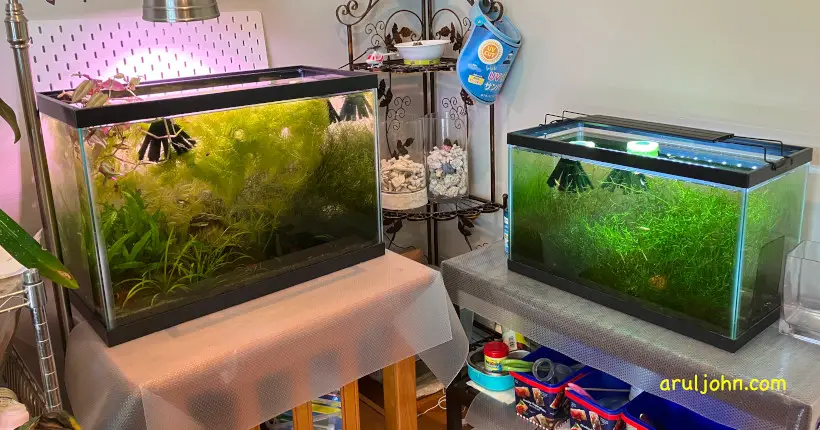 My Japanese rice fish medaka tanks
My Japanese rice fish medaka tanks
Table of Contents
- Introduction to Japanese Rice Fish / Medaka
- Minimum requirements
- What you need
- Extra stuff
- Lay out the substrate in the 20 gallon tank
- Lay out the substrate in the 10 gallon baby tank
- Aquascape the tanks
- Add the cholla wood and plants
- Add the shrimp and snails
- Why is there no filter?
- Why is there no heater?
- Add the medakas
- What food do you feed the medakas?
- Any deaths?
- Breeding the medakas
- Make a spawning mop
- How do spawning mops work?
- Put the female medaka with eggs in a bucket with spawning mop
- Two weeks later, baby medakas were born
- More photos of the medakas
- Outdoor planter
- Japanese Rich Fish Medakas in Space
- Updates
- Disclaimer
Introduction to Japanese Rice Fish / Medaka
Japanese rice fish or as they are known in Japanese, Medaka, are very hardy killifish. The scientific name is Oryzias latipes and they belong to the genus Oryzias, which means rice fish. They are very easy to maintain and breed. In their native land, they are found in rice fields in Japan. They grow up to 1.5 inches in length and can handle varying temperatures from 85F to below freezing. They can live up to 4 years under the right conditions.
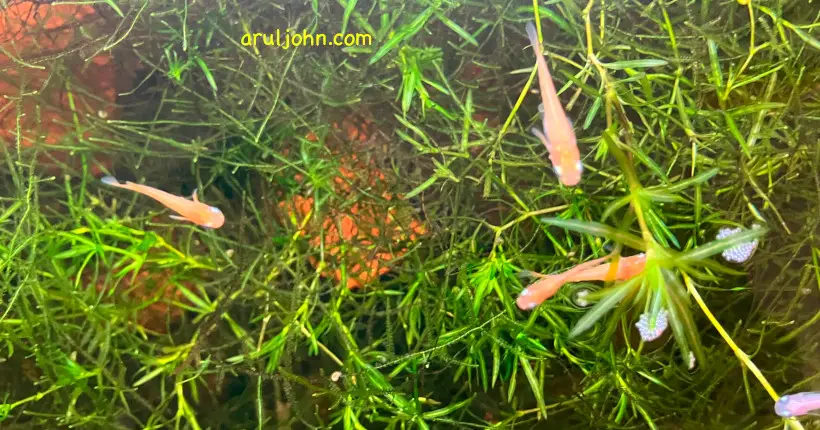 Youkihi Japanese rice fish medakas
Youkihi Japanese rice fish medakas
The colors can vary, depending on the type. We have Youkihi medakas and Pearl Galaxy medakas. My daughter Muthya (Telugu/Tagalog/Sanskrit name for Pearl) selected them.
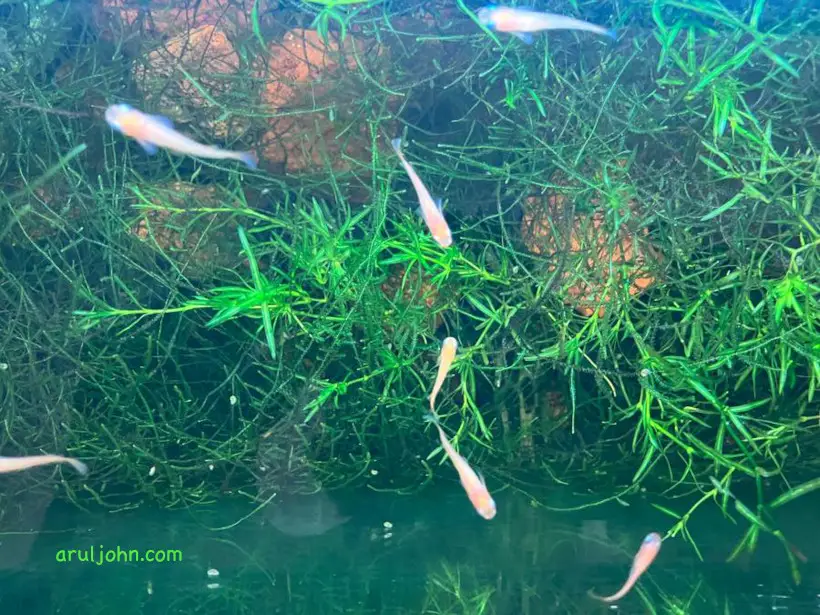 Pearl Galaxy Japanese rice fish medakas
Pearl Galaxy Japanese rice fish medakas
For the sake of consistency, I will refer to them as medaka throughout the rest of this blog post.
Minimum requirements
The minimum tank size is 10 gallons for a school of 6. We have two planted tanks of sizes 10 and 20 gallons. Ours are heavily planted and run on almost no-tech except for the lights. If you are not sure you can do this, buy a filtration system and at the very least a sponge filter.
What you need
- 20 Gallon Aquarium: For adult medakas
- 10 Gallon Aquarium: For new born babies
- Substrate: Caribsea natural white sand. You can use pool filter sand as well.
- Light: One plant LED growlight with rating 6500K
- Lava Rocks: Several lava rocks from Home Depot and Petco
- Cholla Wood: Several cholla wood pieces from Etsy
- Plants: Java moss, guppy grass, hornwort, duckweed, crypts, valisnaria, dwarf saggitaria
- Invertebrates: Several shrimp, Nerite snails, a few ramshorn and Malaysian trumpet snails
- Fish: 6 Pearl Galaxy medakas, 6 Youkihi medakas, a few N class endlers
- Air Stone: None
- Filter: No filter
- Heater: No heater
Extra stuff
- 3 or 5 Gallon Food Safe Bucket, or Sterlite container: Used as a holding container for medaka eggs.
- Short PVC pipes with elbow connectors: Used as hiding spots for baby fish and shrimp
- Caves: Used as hiding spots for baby fish and shrimp
- Driftwood: Used to give the tank a more natural look and provide hiding spots
Lay out the substrate in the 20 gallon tank
We first rinsed the Caribsea white sand. It was quite clean from the start, so this step may not have been necessary. We then spread out the Caribsea sand substrate at the bottom of the 20-gallon aquarium up to a height of 1.5".
We reused lava rocks from our previous tanks without letting them get dry. Lava rocks are highly porous and can house beneficial bacteria from the previous aquarium.
One lava rock from Petco is huge and flat. The others are relatively smaller.
You can aquascape the tank however you want. Just make sure there are pathways small enough for baby fish to swim and escape, and hiding spots.
Normally, cycling a new tank from scratch without media from a previous tank should take 2-4 weeks. This tank got instantly cycled and can be tested with a water testing kit.
This is the latest photo of the 20 gallon planted tank, taken June 2024.
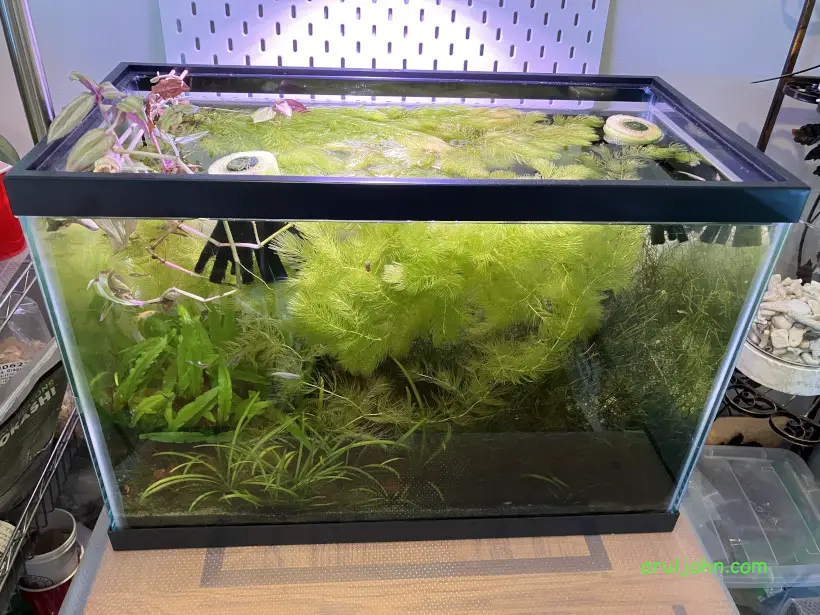 Japanese rice fish medaka 20 gallon planted tank
Japanese rice fish medaka 20 gallon planted tank
Lay out the substrate in the 10 gallon baby tank
Spread out about 1" high Caribsea white sand at the bottom. I also put a lot of lava rocks on top. There are microorganisms that grow on these rocks and baby fish like nibbling off whatever is in there.
Similar to the 20 gallon tank, one lava rock from Petco is huge and flat.
We also put Java moss and guppy grass and let them float.
We added a cave for babies to hide from juveniles.
This is the latest photo of the 10 gallon planted tank, taken June 2024.
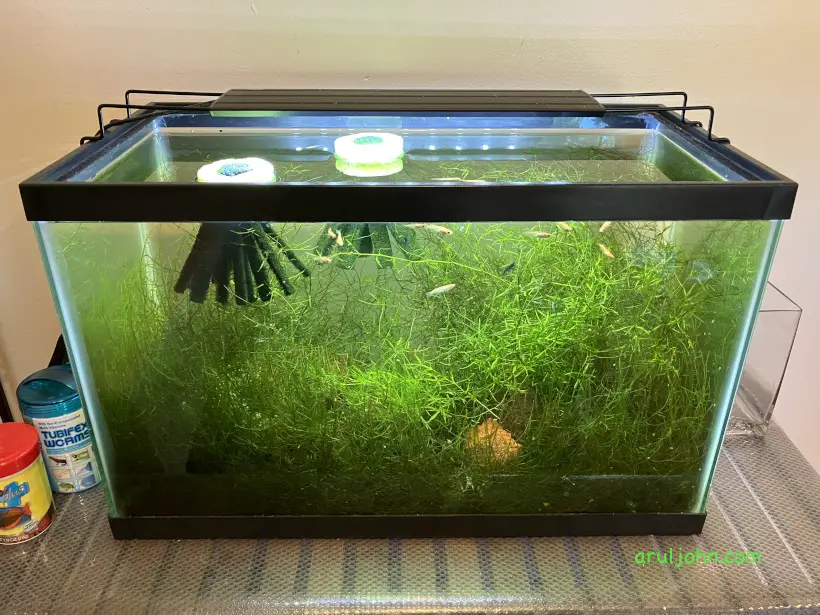 Japanese rice fish medaka 10 gallon planted tank
Japanese rice fish medaka 10 gallon planted tank
Aquascape the tanks
We bought two large lava rocks from Petco and regular sized lava rocks (red and black) from Home Depot. The dimensions of these large lava rocks are 6 inches x 4 inches x 4 inches each. I wanted lava rocks with large surface area and ended up with one flat plateau kind of rock and another with a hilly look. Shrimp and baby fish seem to like both sized rocks.
Lava rocks are a great addition to any shrimp tank because of the pores and holes in them. These pores house beneficial bacteria called denitrifying bacteria. They also help with maintaining the nitrogen cycle, and help break nitrate to form nitrogen and oxygen. Shrimp also love to forage on lava rocks to search for food.
Lava rocks are inert, so they do not alter the water chemistry.
Arrange the rocks the way you want it to be.
I also added a few PVC pipes with elbow connectors for baby fish to have hiding spots and placed rocks on top.
 My Japanese rice fish medaka tanks
My Japanese rice fish medaka tanks
Add the cholla wood and plants
In the 20 gallon tank, we planted crypts, vals and dwarf saggitaria into the substrate.
In the 10 gallon tank, we added Java moss, guppy and hornwort and allowed them to float as opposed to being tied down.
I'm reusing the cholla wood along with new ones in both these aquariums. Arrange them however you want, aesthetically.
Cholla wood is soft and will break down over time. Cholla wood grows biofilm as it breaks down. This biofilm is great for the shrimp and baby fish to forage on.
You can buy cholla wood from Etsy. Do NOT buy the painted cholla wood because they can be toxic.
Add the shrimp and snails
I bought 20 odd shrimp culls from a local seller and put a few in each tank. We also added a few Malaysian trumpet snails, ramshorns and a Nerite snail to each tank.
Shrimp and snails are scavengers. They eat up the leftover food and the algae as well, thus keeping the aquarium glass clean. Nerite snail for every 10 gallons is the perfect vacuum cleaner. The ramshorns do a similar job. The Malaysian trumpet snails keep burrowing through the sand substrate, thus aerating the sand and keeping it from creating anerobic pockets (which are oxygen-deprived). Malaysian trumpet snails also constantly graze on algae on the glass as well as substrate itself. With all these little critters, the tank looks generally clear and clean.
Why is there no filter?
The plants act as a biological filter. They convert the CO2 byproducts into oxygen. I do not need another biological filter because of the densely populated jungle made by Java moss, guppy grass and hornwort. I also do not need a mechanical filter, though an air bubbler may benefit if I were to add more livestock (in this case, fish).
Why is there no heater?
The temperature of my house stays at a constant 74 Fahrenheit. Sometimes it goes as low as 72F, but that's about it. Blue diamond shrimp can thrive in temperatures of 64° to 78° F. All fish, snails and shrimp are happy with this temperature range as well.
Medakas live in a wide range of temperatures. Endlers are hardly little fish too.
Add the medakas
We ordered 6 Youkihi and 6 Pearl Galaxy medakas from a seller in the west coast. We received the medakas from the west coast after a 3-day FedEx shipping.
At this point, we had already crossed 7 days of cycling. The tanks were good and the invert residents were still intact, so we added the medakas. We added endlers as well, and they have generally coexisted happily.
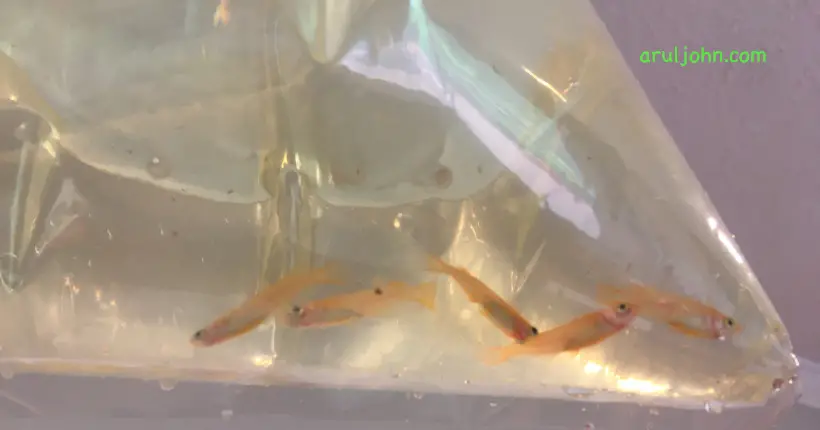 6 Youkihi Medakas in the bag
6 Youkihi Medakas in the bag
What food do you feed the medakas?
We fed the medakas Tetra flakes and Hikari tubifex freeze dried worms. They seem to like both foods.
Every now and then, let them eat earthworms from your garden or backyard, or a piece of raw shrimp from your freezer.
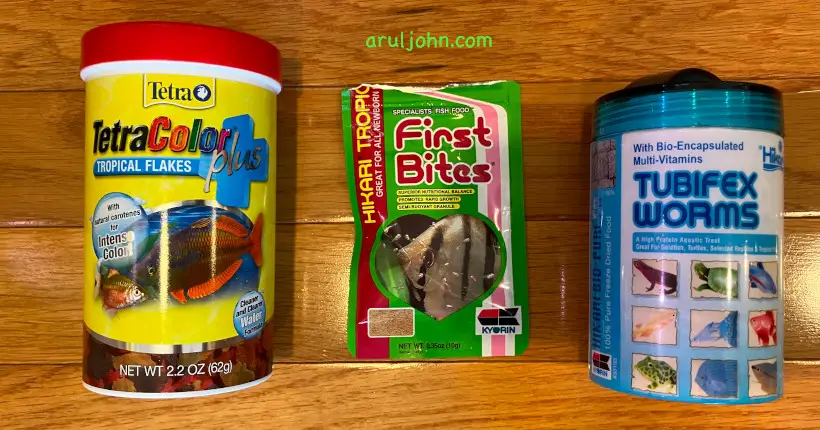 Tetra flakes, Hikari tubifex freeze-dried worms
Tetra flakes, Hikari tubifex freeze-dried worms
Any deaths?
Unfortunately, one Youkihi medaka died on the third day, so I took a photo and sent it to the breeder. He immediately gave a refund on the price of the medaka.
A few days later, two more Youkihi medakas died. I didn't bother to tell this to the seller. The Pearl Galaxy medakas were all there.
Breeding the medakas
After a month, I saw the female medakas carrying eggs in the mornings.
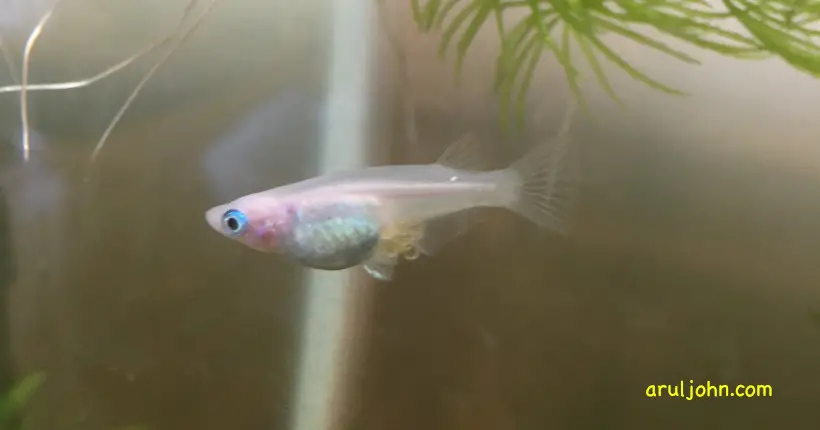 Female Pearl Galaxy medaka with eggs
Female Pearl Galaxy medaka with eggs
By afternoon, the eggs were gone. They probably fell off the female medaka and got lost in the Java moss jungle or on the substrate. It's time to make a medaka spawning mop so we can increase the hatch rate by collecting the eggs and separating the medaka mom in the process.
Medakas love to rub their eggs against something rough or that has friction, and then the eggs latch on to that new object. If there is a heavily planted tank like ours, medakas rub themselves over the plants, leaving eggs all over the place. Unfortunately, the eggs can be eaten by the adults.
Also, when the eggs hatch and the babies are born, they become instant food for the adults, so it's a good idea to isolate medaka eggs in something like a smaller bucket or Sterlite container.
Make a spawning mop
A spawning mop is perfect for holding medaka eggs.
I went to Dollar Tree and bought a 4-pack of Scotch Brite pads and a pool noodle.
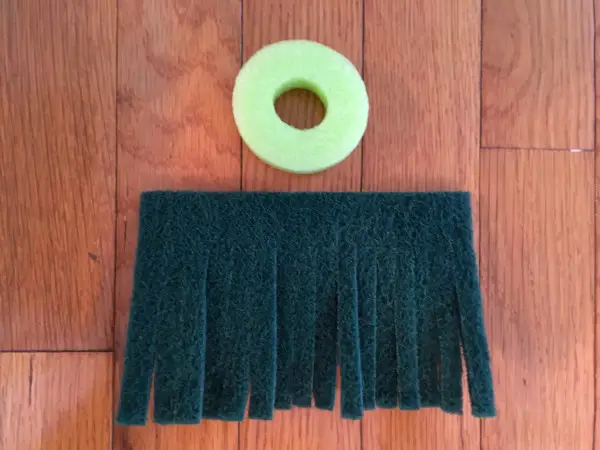 Scotch Brite pad and pool noodle
Scotch Brite pad and pool noodle
I cut the pool noodle with a sharp knife to create a donut-shaped top. Then, I sliced the Scotch Brite pad this way.
I then rolled it up and fitted it into the pool noodle donut.
The end product was this spawning mop, which resembles a jellyfish. I created several spawning mops.
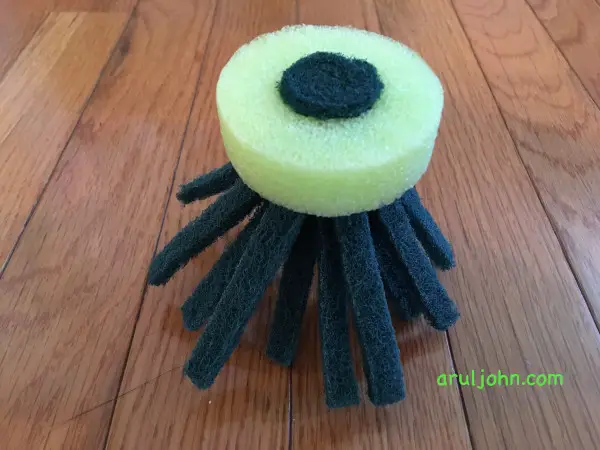 Spawning mop
Spawning mop
How do spawning mops work?
In the case of medakas, the spawning mops provide for a rough surface for them to rub against so the eggs can separate from the body.
When female medakas are put in a container with only water and spawning mops, and nothing with a rough surface (like plants), they tend to rub aginst the spawning mops. That maximizes the number of eggs latching on to the spawning mops.
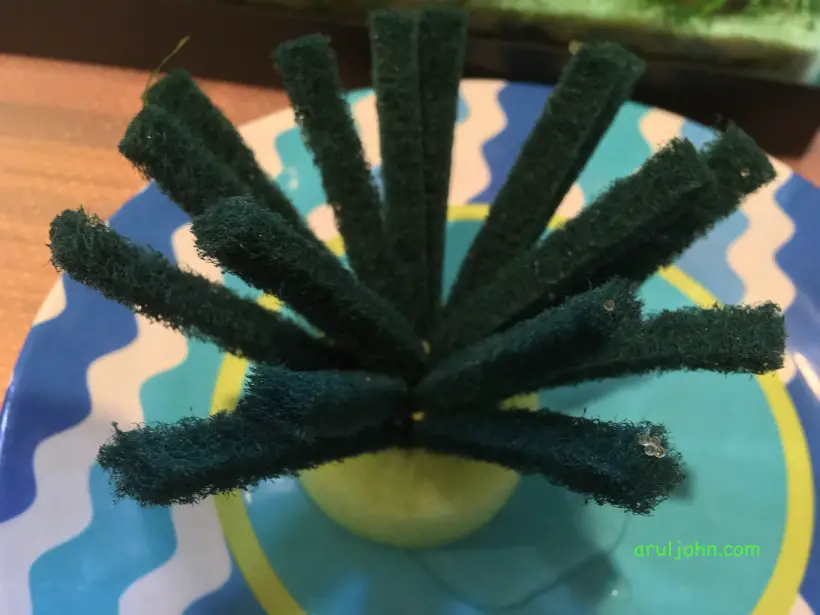 Spawning mop with medaka eggs
Spawning mop with medaka eggs
You can see several translucent spherical eggs on the spawning mop bristles. Here is a closeup.
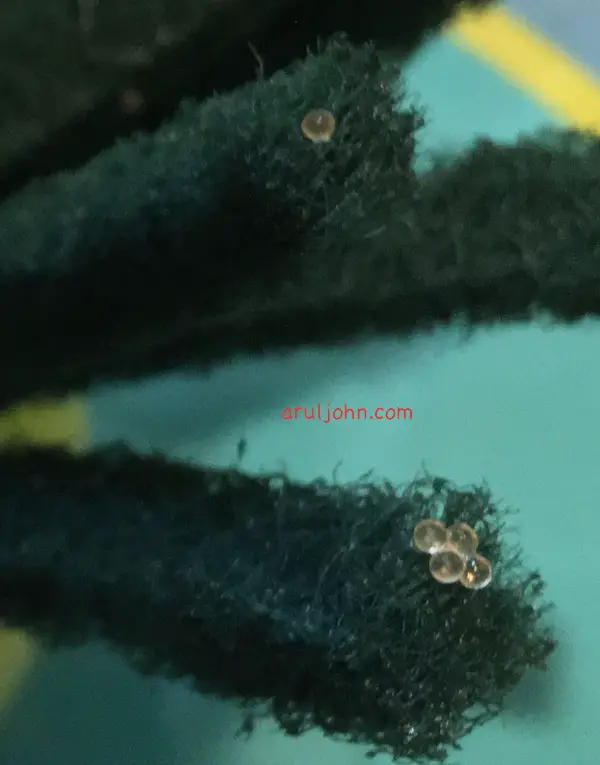 Close up look of the spawning mop with medaka eggs
Close up look of the spawning mop with medaka eggs
If you put spawning mops in a planted tank and there are females with eggs, chances are they may or may not use the spawning mops.
Put the female medaka with eggs in a bucket with spawning mop
In the mornings before 9am, after seeing a number of eggs on the female medakas, I netted the female medakas gently and put them in the bucket with shallow water and only a couple of spawning mops.
After a couple of hours, the medakas transferred their eggs to the spawning mop.
I then put the spawning mop into the 10 gallon planted tank for them to hatch in 2 weeks. And the moms went back to the 20 gallon tank.
I repeated this process for a few days and finally, had eggs on all the spawning mops.
At this point, I left the female medakas in the 20 gallon tank, while the 10 gallon tank had several spawning mops with several eggs on them.
Two weeks later, baby medakas were born
Two weeks later, I saw the first bunch of 10+ baby medakas. We fed them Hikari baby pellets a few times a day. They appear hungry all the time. They also loved pecking and foraging on the microorganisms on the Java moss and lava rocks. They were competing with the shrimp for food invisible to the human eye.
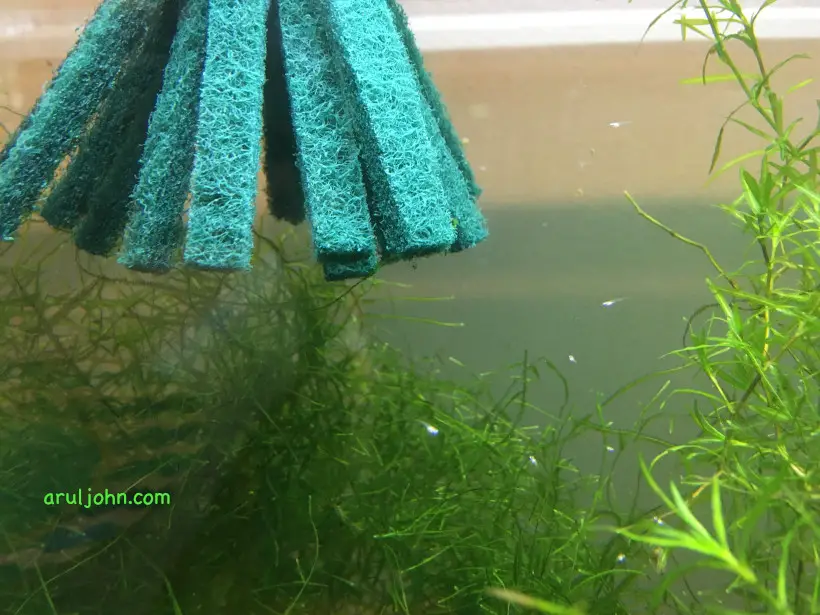 Newly born baby Pearl Galaxy medakas
Newly born baby Pearl Galaxy medakas
They grew quite well, though slowly. As more eggs hatched, this cave provided a safe hiding space for the smaller fish against the larger juveniles.
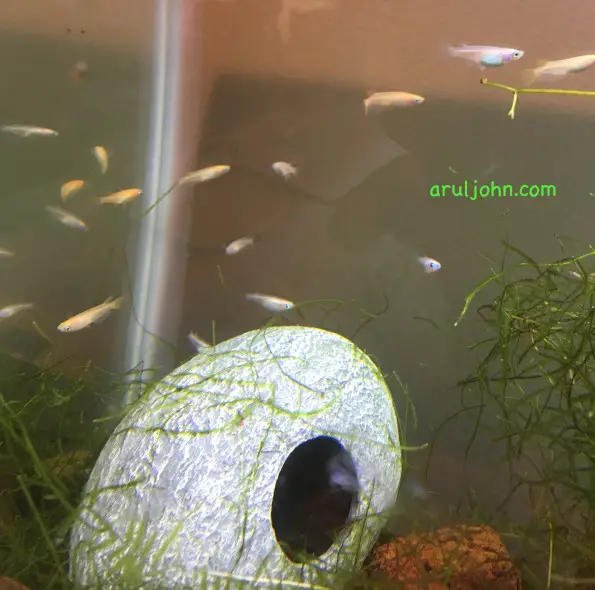 Cave safe spaces for baby Youkihi and Pearl Galaxy medakas
Cave safe spaces for baby Youkihi and Pearl Galaxy medakas
More photos of the medakas
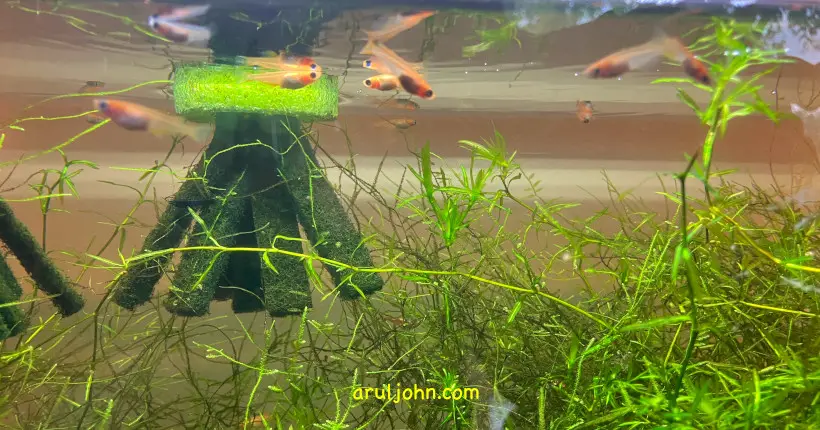 Youkihi Japanese rich fish medakas in the 10 gallon tank
Youkihi Japanese rich fish medakas in the 10 gallon tank
 More pictures of the Youkihi Japanese rich fish medakas in the 10 gallon tank
More pictures of the Youkihi Japanese rich fish medakas in the 10 gallon tank
Outdoor planter
After the first batch of medakas were born, I also tried putting a few of these juvenile Pearl Galaxy medakas in a 5 gallon outdoor planter.
Unfortunately, they kept disappearing. And then, I found that the local birds were feasting on them. That was before I put a transparent cover on top of the planter.
This summer of 2024, I plan to put a few of the younger medakas out in this planter. I want to observe and see if the growth progress is better in the outdoor planter than the indoor fish glass tanks.
Japanese Rich Fish Medakas in Space
Medakas were the first vertebrates to be born in space. They have been considered for long-term space experiments involving microgravity. These experiments, code named "MEDAKA", were carried out in July 1994 in the IML-2 (International Microgravity Laboratory). The objective was to observe mating behavior of the medakas and development of their eggs, while collecting data for designing fish culture in space.
A total of 43 eggs were,laid: 8 babies hatched in space, 30 fry hatched after landing, and 5 eggs stopped development at early stages.
Four medakas (2 males and 2 females) were involved in this. The medakas successfully mated and laid 43 eggs. 8 babies were hatched successfully in microgravity. These were the first vertebrates to be successfully born and were named "space-originated fry".
Medakas were proven to be the most likely candidates for further research for fish born in space.
Updates
June 2024
There has been a lot of overgrowth of plants, especially the hornwort. Usually, it would be the Java moss and guppy grass that grows like crazy. Because of this, the medaka eggs have been relatively safe and I saw a few new babies born with their eggs successfully hatching.
Several new endler babies were born a few days ago. While endlers coexist happily with medakas, they are faster than medakas, so I have to watch the medakas actually eat their food for me to make sure they are not starved.
I sold a few Youkihi medakas to someone local.
As of June 8th, there are quite a few Youkihi and Pearl Galaxy medakas with eggs. I will start putting them in the bucket with mops, so I can collect eggs.
I took out the planter, and will update this blog post with photos of the outdoor mini pond.
October 2023-June 2024
It was a lazy winter. The medakas did not breed much. However, the plants had to be trimmed every few weeks and I ended up selling Java moss and guppy grass to different buyers.
Disclaimer
Your results may vary. Please let me know how it worked out for you.
Related Posts
If you have any questions, please contact me at arulbOsutkNiqlzziyties@gNqmaizl.bkcom. You can also post questions in our Facebook group. Thank you.